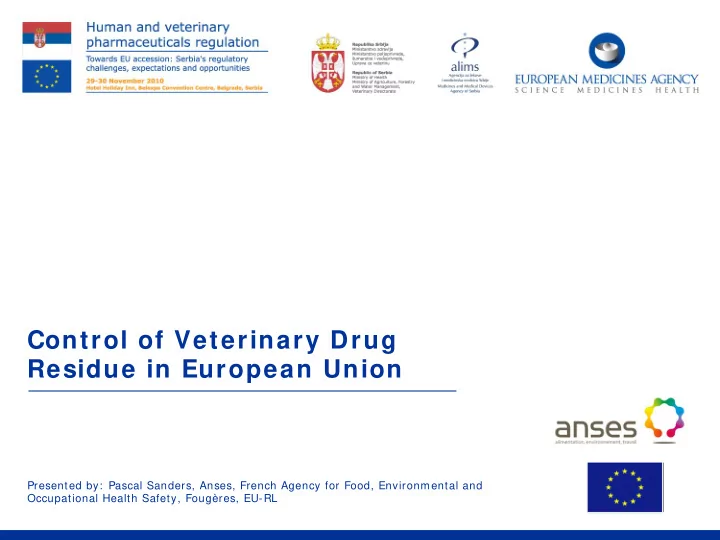

Control of Veterinary Drug Residue in European Union Presented by: Pascal Sanders, Anses, French Agency for Food, Environmental and Occupational Health Safety, Fougères, EU-RL
Outline Legal framework Laboratory organisation Analytical methods Conclusion 2
Legal Fram ew ork : Council Regulation 4 7 0 / 2 0 0 9 Veterinary drugs, Biocides • Maximum residue limit (MRL) Table 1 : Substances for which MRLs have been established. • Animal Species, use Table 2 : Substances for which no MRL could be established because of an uncertainty about the risk. • The administration of substances listed in this table to food-producing species is prohibited. Reference Point of Action • EU-RL and EFSA 3
Legal Fram ew ork : Directive 9 6 / 2 3 / CE Regulation of residue control Group of compounds • Compounds group A : Substances w ith anabolic effect and unauthorized substances ( A6 : Table 2 Reg 4 7 0 / 2 0 0 9 ) • Compounds group B : Veterinary drugs residue and contam inants 4
Legal Fram ew ork : Directive 9 6 / 2 3 / CE Competent authority tasks • Annual control programme • Inspection Laboratories tasks • European Union Reference Laboratory • National Reference Laboratory • Routine Laboratory Methods validated according decision 2002/ 657 Quality assurance system : ISO17025 5
DIRECTIVE 96/ 23 Number of controlled animals Species Group A Group B (% of annual production) 50% live animal 0.15% (30% for groups B1) 0.25% 50% Bovine 0.4% slaughterhous e 0.02% 0.03% (30% for group B1) Porcine 0.05 % 0.01% 0.04% Sheep and Goat 0.05 % Equine In relation to the problems identififed 1 per 200 tons of annual 50% of samples Poultry (broiler 50% of samples production chicken, (30% for group B1) (minimum : 100) turkeys) 1 per 100 tons of annual 33% of samples 67% Aquaculture production products Milk except sheep 1 per 15000 tons of 70% for veterinary medicament and 30% for B3 and goat milk annual production 1 per 1000 tons 70% for groups A6, B1, B2b and 30% in relation to the problems Eggs (equivalent ton) identififed (B3a ) 10/300 tons (3000 50% for groups B1 and B2c and 40% for groups B3a, B3b, B3c Honey tons) + 1/300 tons
Directive 9 6 / 2 3 : Annex I GROUP A6 Aristolochia spp. and preparations thereof Chloramphenicol Chloroform Chlorpromazine Colchicine Dapsone Dimetridazole Metronidazole Nitrofurans (including furazolidone) Ronidazole 7
Directive 9 6 / 2 3 : Annex I Group B : Veterinary drugs & contam inants ( 1 ) Antibacterial substances, including sulphonam ides, quinolones ( 2 ) Other veterinary drugs ( a) Anthelm intics ( b) Anticoccidials, including nitroim idazoles ( c) Carbam ates and pyrethroids ( d) Sedatives ( e) Non-steroidal anti-inflam m atory drugs ( NSAI Ds) ( f) Other pharm acologically active substances (3) Other substances and environmental contaminants (a) Organochlorine compounds including PCBs (b) Organophosphorus compounds (c) Chemical elements (d) Mycotoxins 8 ( e) Dyes (f ) Others
Laboratory netw ork EU-RLs Anses Fougères : B1+ B3e + A6 BVL Berlin B2 a,b,c + A6 RIVM Wageningen B2 d + A6 NRLs : 1 or more/ MS Routine laboratories 9
Legal Fram ew ork : Decision 2 0 0 2 / 6 5 7 COMMI SSI ON DECI SI ON of 1 2 August 2 0 0 2 im plem enting Council Directive 9 6 / 2 3 / EC concerning the perform ance of analytical m ethods and the interpretation of results. • MRL or MRPL ( Minim um required perform ance level ) • Use of validated m ethods – Performance criteria for analytical methods Decision limit (CC α ) : limit at and above which it can be • concluded with an error probability of α that a sample is non-com pliant . Detection capability (CC β ) : smallest content of the • substance that may be detected , identified and/ or quantified in a sample with an error probability of β . – Criteria to confirm presence of a compound in a matrix.. • Definition of « com pliant sam ple » 10
Screening Methods False compliant rate of < 5 % ( β -error) at the level of interest. CC Precision Selectivity Applicability Specificity Ruggedness Qualitative + - + + Quantitative + + + + Biological Biochemical Chemical Methods methods Methods Qualitative Tube test Snap test HPTLC spot Bacterial Growth Quantitative ELISA HPLC inhibition zone Receptor test HPLC/MSMS 11
Confirm atory m ethods Group A Group B X X LC or GC with mass-spectrometric detection X X LC or GC with IR spectrometric detection X LC-full-scan DAD X LC –fluorescence X 2-D TLC - full-scan UV/VIS * GC-Electron capture detection * LC-immunogram * LC-UV/VIS (single wavelength) * At least two different separation systems 12
Confirm atory m ethod validation Qualitative Quantitative Detection limit CC + + Decision limit CC + + Trueness/recovery - + Precision - + Selectivity/specificity + + Applicability + + Ruggedness/Stability + + 13
Major class of veterinary drugs : Exam ples Screening Confirmatory Growth inhibition, LC/UV, LC/MSMS Betalactams Receptor test Receptor test LC/UV, LC/MSMS Tetracyclins LC/Fluo LC/Fluo, LC/MSMS Fluoroquinolones HPTLC, LC/UV LC/UV, LC/MSMS Avermectines HPTLC,LC/UV LC/UV, LC/MSMS Benzimidazoles LC/UV LC/UV, LC/MSMS Sedatives HPTLC, ELISA, LC LC/MSMS Coccidiostats 14
I nterlaboratory studies Three different objectives • Interlaboratory validation of methods – Reproducibility & repeatability • Production of certified reference material (CRM) – Cooperation with Joint Research Center • Proficiency test – Performance of laboratory network – Improvement of quality assurance 15
Conclusion Twenty years of analytical progress • Technological progress • Development of laboratory performance Quality assurance / Proficiency test Revision of Directive 96/ 23 planned • Targeted control vs exposure monitoring • Food law requirements • Responsibility at all stages by food business operators 16
Thank you for your attention 17
Recommend
More recommend